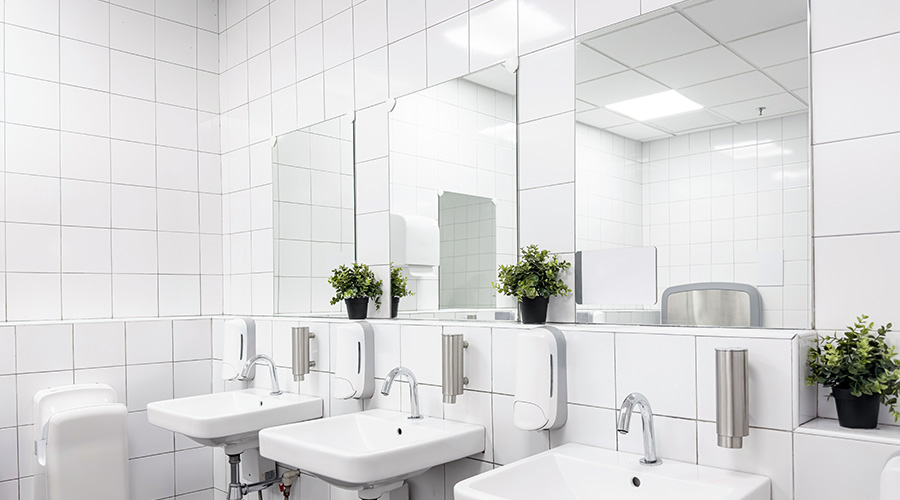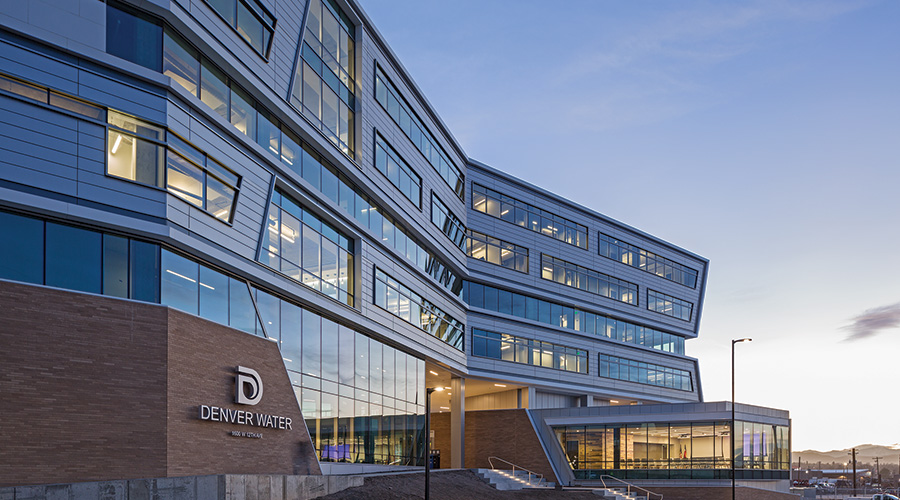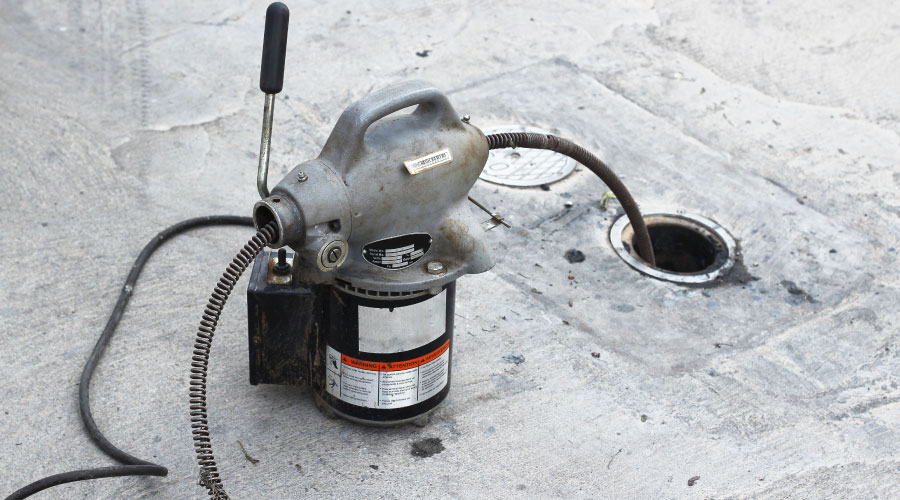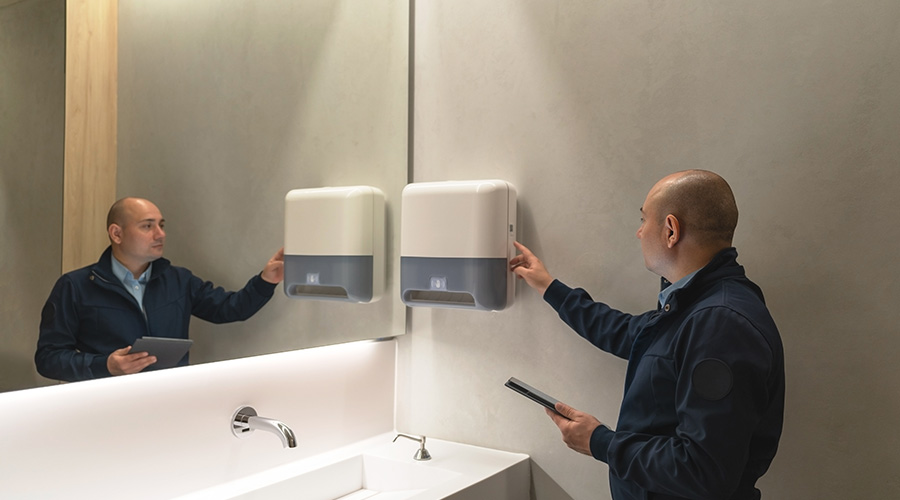Details key to cost-effective design
While first costs play an important role in selecting restroom designs and fixtures, they are not the only factor or even the most important factor that must be considered. Good restroom designs minimize maintenance requirements, are energy- and water-efficient, minimize the use of dispensed products, resist vandalism and use long-lasting fixtures and surfaces. They also project the image that is important to the organization.
The leading complaint concerning restrooms is that they are not clean. Dulled finishes, stained surfaces and low-quality lighting systems help create the appearance of a dirty restroom even when in fact it may be sanitary. In many applications, it is simply a case of poor planning. Traffic flow is underestimated. The design may make the restroom impossible to maintain properly.
Before a new design is started, it is worthwhile to examine other restrooms in the facility and in other facilities to see design elements that don’t work. For example, the use of porous paints on walls makes the cleaning of dirt and the removal of graffiti almost impossible. Tile grout that was never sealed is easily stained. Inattention to traffic flow patterns within the restroom increases congestion and lowers the use level that the restroom can support. Poor lighting fixture placement can make changing bulbs difficult. Poor lighting system design can make the restroom look unclean.
A good restroom design starts with an understanding of the needs of the users. The design of a restroom in a busy area will require additional fixtures and attention to traffic flow, and finishes must be selected at least in part on their ability to withstand the expected level of use. In determining the expected level of use, consider both the average rates and any surges in use. Although codes identify the size of the restroom, code requirements should be seen as a minimum. In many cases, additional fixtures will be required.
Image is also crucial. High-profile applications require that the restroom project the same quality image as the rest of the facility. High ceilings, open spaces, accented lighting, luxurious finishes and privacy support this image.
Abuse and vandalism must also be considered. Careful selection of materials and finishes can reduce the impact of vandalism. Recessed dryers and paper towel dispensers offer fewer opportunities for vandalism. Even the use of touchless fixtures can significantly reduce vandalism.
Focus on Cleaning
Over the 20-year life of the restroom, the cost of cleaning will exceed the cost of fixtures — perhaps even the cost of renovation. If restrooms are difficult to keep clean, costs will increase unnecessarily or service will suffer. Cleaning costs must be factored into every decision made concerning the restroom construction or renovation.
Don’t overlook any restroom component — ceilings, floors, wall finishes, partitions and fixtures. In many cases, selecting a component that makes cleaning easier will not increase the overall cost of the restroom design. But the wrong one can drive cleaning costs up significantly.
A gloss finish prevents dirt from becoming embedded in paint. Ceiling tile can be readily changed should it become stained. Ceiling tile also provides easy access to piping and other systems located above the ceiling. Ceiling tile should resist damage from dirt and moisture. In a restroom, dirt resistance is more important than acoustics.
All wall and floor materials should be selected on their ability to resist damage from moisture. Although initial appearance is important, facility executives must remember floors and walls in restrooms are exposed to moisture and dirt more than floors and walls anywhere else in the facility. Even the frequent cleanings that take place in restrooms can ultimately damage materials that are not highly resistant. Wall and floor tile grout must be sealed to prevent damage from moisture and graffiti.
Restroom partitions should be constructed from materials and compounds that will not corrode and that resist vandalism. All partitions should be wall- and ceiling-mounted only; toilet and urinal fixtures should be wall-mounted at a sufficient height to ease floor cleaning.
Integrating fixtures — such as soap dispensers, paper towel dispensers and trash containers — can also reduce the frequency and the amount of time required to clean the restroom. Recessing fixtures also protects them from vandalism and accidental damage.
Not all cleaning products will be compatible with finishes and fixtures in the restroom. Using the wrong type of cleaner may accelerate the deterioration of the component being cleaned. Some cleaning products may not be compatible with others. By identifying products required to clean each element in the restroom, facility staff can consider alternative elements that may reduce cleaning product needs.
Each restroom cluster must include storage for supplies to stock and clean the restrooms. Otherwise, time will be wasted retrieving supplies.
Maintenance Needs
Maintenance requirements must be considered early in planning. For example, every fixture must include an isolation valve to allow maintenance personnel to shut down individual fixtures. The alternative may be closing a restroom or cluster of restrooms for even simple maintenance.
Fixtures must be matched to the expected level of use, or maintenance requirements and costs will increase.
Maintenance must also be factored into fixture selection. Some flush valves and faucets make it easier to replace key wear components.
Touchless controls can reduce the cost of maintaining restrooms and the quantity of water used. Although the automatic units typically cost nearly twice as much as manual ones, savings from lower water use recovers the additional expense in one to two years. And by eliminating the need to touch flush valves and faucet controls, wear, abuse and vandalism are all reduced.
Urinals that do not require water are also available. The urinals reduce water and sewer charges. Maintenance costs associated with flush valves are also eliminated. In new construction, there is no need for a flush valve, sensor or a water feed line for the urinals.
Hand dryers, paper towel dispensers and soap dispensers have also gone touchless. Automatic shutoff can reduce hand dryer energy use by up to 50 percent. Touchless paper towel dispensers and soap dispensers reduce product use by one-third on average, saving product and labor costs.
An often overlooked yet important element in restroom designs is the lighting system. Poor lighting system design can create a dirty appearance. Systems that over-light the space are uncomfortable to users and waste energy. Those that do not provide enough light can cause shadows and dark areas, creating hazards.
Most restrooms are unoccupied 75 percent of the time or more, yet lighting systems operate continuously. By installing high-efficiency lighting fixtures and controlling them with occupancy sensors, facility executives can reduce lighting energy use by 90 percent. Careful design and placement of occupancy sensors will minimize energy use without compromising safety.
Related Topics:











